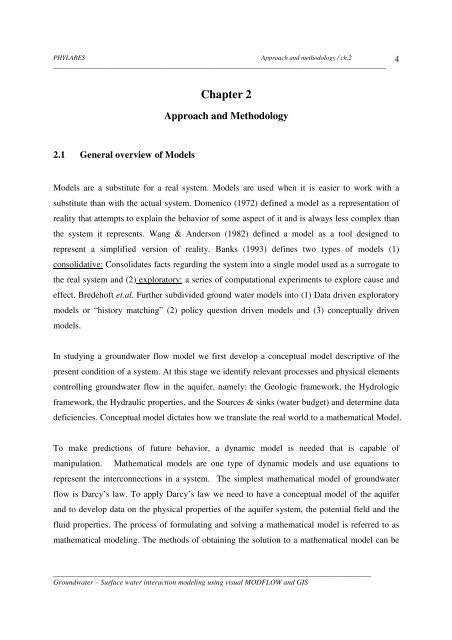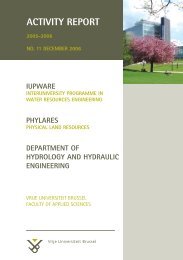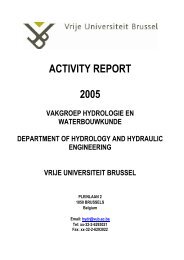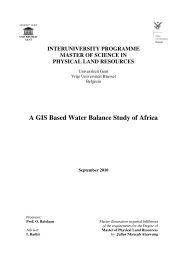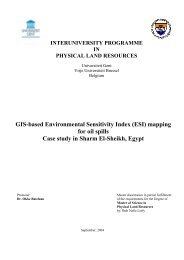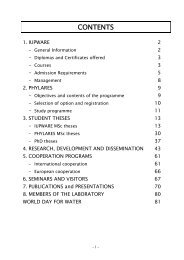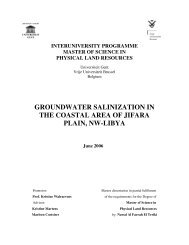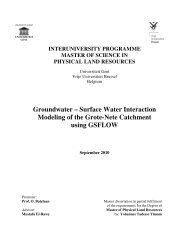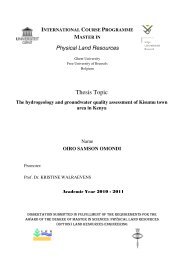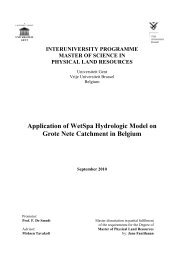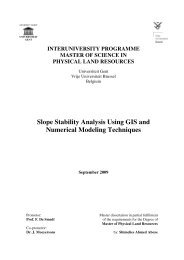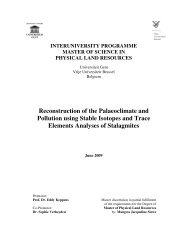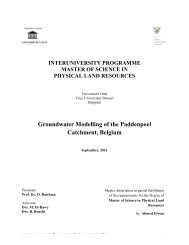Surface Water Interaction Modelling Using Visual MODFLOW and GIS
Surface Water Interaction Modelling Using Visual MODFLOW and GIS
Surface Water Interaction Modelling Using Visual MODFLOW and GIS
- No tags were found...
You also want an ePaper? Increase the reach of your titles
YUMPU automatically turns print PDFs into web optimized ePapers that Google loves.
PHYLARESApproach <strong>and</strong> methodology / ch.2__________________________________________________________________________________________4Chapter 2Approach <strong>and</strong> Methodology2.1 General overview of ModelsModels are a substitute for a real system. Models are used when it is easier to work with asubstitute than with the actual system. Domenico (1972) defined a model as a representation ofreality that attempts to explain the behavior of some aspect of it <strong>and</strong> is always less complex thanthe system it represents. Wang & Anderson (1982) defined a model as a tool designed torepresent a simplified version of reality. Banks (1993) defines two types of models (1)consolidative: Consolidates facts regarding the system into a single model used as a surrogate tothe real system <strong>and</strong> (2) exploratory: a series of computational experiments to explore cause <strong>and</strong>effect. Bredehoft et.al. Further subdivided ground water models into (1) Data driven exploratorymodels or “history matching” (2) policy question driven models <strong>and</strong> (3) conceptually drivenmodels.In studying a groundwater flow model we first develop a conceptual model descriptive of thepresent condition of a system. At this stage we identify relevant processes <strong>and</strong> physical elementscontrolling groundwater flow in the aquifer, namely: the Geologic framework, the Hydrologicframework, the Hydraulic properties, <strong>and</strong> the Sources & sinks (water budget) <strong>and</strong> determine datadeficiencies. Conceptual model dictates how we translate the real world to a mathematical Model.To make predictions of future behavior, a dynamic model is needed that is capable ofmanipulation. Mathematical models are one type of dynamic models <strong>and</strong> use equations torepresent the interconnections in a system. The simplest mathematical model of groundwaterflow is Darcy’s law. To apply Darcy’s law we need to have a conceptual model of the aquifer<strong>and</strong> to develop data on the physical properties of the aquifer system, the potential field <strong>and</strong> thefluid properties. The process of formulating <strong>and</strong> solving a mathematical model is referred to asmathematical modeling. The methods of obtaining the solution to a mathematical model can be______________________________________________________________________________________Groundwater – <strong>Surface</strong> water interaction modeling using visual <strong>MODFLOW</strong> <strong>and</strong> <strong>GIS</strong>


